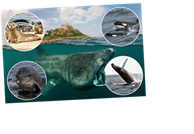A SAFARI in Africa may be off the cards for now but there’s a wealth of wildlife right here at home just waiting to be explored once lockdown lifts.
Here Lisa Minot goes on a whistle-stop tour around the UK to show you how you can spot everything from whales to red squirrels along our coasts and countryside.
Read on to plan your wildlife safari for when we can travel again.
Sharks in Cornwall
AS long as a double-decker bus and weighing up to seven tons, the basking shark is the world’s second-largest fish and can live for 50 years.
You are most likely to see them off the Cornish coast between May and July.
Marine Discovery has wildlife-watching boat trips from Penzance.
The two, three or four-hour trips are from £28 adults and £20 under-16s. See marinediscovery.co.uk.
Or take a snorkelling trip with commercial diver Charles Hood from Penzance.
Prices start from £150 per day. See charles-hood.com.
Basking sharks can also be seen off Lyme Bay, Dorset, and Cardigan Bay in Wales.
Seals in Norfolk
BLAKENEY Point is home to England’s largest colony of grey seals.
Book a trip on one of the local ferry trips departing from Morston Quay.
Summer sees a host of operators offering daily trips to Blakeney Point.
And even in colder months you can visit to experience the 3,000-plus pups born each winter.
Beans Boats (beansboattrips.co.uk) has hour-long tours from £13.
Also offering tours are Bishops Boats (bishopsboats.co.uk) and Temples (sealtrips.co.uk).
Also try Skomer Island, Pembrokeshire, and Donna Nook, Lincs.
For more details, see wildlifetrusts.org.
Otters in Lancashire
THE return of otters to British waterways is one of the country’s top conservation success stories.
Try spotting them at Aughton Woods, a remote ancient woodland on the River Lune.
Dawn and dusk are best the times to spot them. For details, see lancswt.org.uk.
Otters Den lodges at Whitechapel near Preston are great places to book for wildlife-spotting in general.
The luxury lodges are located next to a lake in the Forest of Bowland. For more details see cottages.com.
Other good sites for otters include Cricklepit Mill in Devon. For details see wildlifetrusts.org/where_to_see_otters.
Red squirrels in Cumbria
THE native red squirrel has been found in England since the end of the last Ice Age but the introduction of the American grey squirrel in the late 1870s saw numbers decline catastrophically.
Some of the best places to spot the red squirrel now include the Argill Woods Nature Reserve near Brough.
Also try Dodd Wood in Keswick, where there are great views from above Bassenthwaite Lake.
Also good for a guaranteed sighting are Greystoke Forest in Penrith and the National Trust’s Allan Bank near Grasmere.
See cumbriawildlifetrust.org.uk.
For other spots to see red squirrels, check out Dorset’s Brownsea Island and Northumberland.
Puffins in Yorkshire
THE cute seabirds arrive in Yorkshire in late March and depart from July onwards so May and June are the best times to spot them.
Flamborough Cliffs allows visitors to view the birds in the wild from open clifftop vantage points at North Landing and Briel Nook.
The RSPB Bempton Cliffs and Seabird Centre has family-friendly viewing areas and a new visitor centre.
Or take to the waters with a cruise onboard the historic Yorkshire Belle pleasure cruiser from Bridlington.
Its Bempton Cliffs cruises run from May to July. See yorkshire-belle.co.uk.
You’ll also see puffins at Farne Islands, Northumberland and along the North Cornish coast but would have to take to the waters to see them.
Humpback whales in The Moray Firth
MAJESTIC humpback whales, or minke whales, have been spotted in this Scottish wildlife haven, as have vast pods of dolphins, porpoise and grey seals.
North 58° Sea Adventures offers two-hour Wildlife Adventures to spot sea creatures with experienced eco-guides.
You can catch boats from Findhorn or Lossiemouth with daily trips seven days a week from March to November.
Prices from £30 adults and £25 kids and include all-weather clothing and life jackets. See north58.co.uk.
Or head to the free WDC Scottish Dolphin Centre at the mouth of the River Spey to spot dolphins from the land.
See dolphincentre.whales.org.
Whales have also been seen off the Hebrides and Fife.
Killer whales in The Shetlands
WITH sightings of orcas or killer whales increasingly common in the Shetland Islands off Scotland, there are now a number of wildlife holidays that incorporate trying to spot them.
While Shetland Nature’s Wild Shetland tour takes in storm petrels on island Mousa and gannets on Noss, orcas are the headline act.
The eight-day trip runs from July 10 to 17 and costs from £1,575pp, including meals, excursions and ferry fares. See shetlandnature.net.
Shetland Seabird Tours runs tours daily from April to October from Lerwick and includes cruises around Bressay and Noss.
Prices from £45 adult and £25 under-16s.
See shetlandseabirdtours.com.
Dolphins in Anglesey
DOLPHIN sightings are common along the shores of Anglesey off the north-west coast of Wales.
Harbour porpoise and bottlenose dolphins regularly visit the island’s coast.
The harbour porpoise sticks to the shallow waters closer to shore making it easier for them to spot but the bottlenose breach the waters for a spectacular display.
Seacoast Safaris offers tours from Beaumaris on the eastern corner of Anglesey to Puffin Island, an uninhabited protected wildlife habitat with a host of nesting sites for breeding sea birds.
Prices are from £30pp. For further details, go to seacoastsafaris.co.uk.
Dolphins are also regularly spotted off the Land’s End peninsula and St Ives Bay in Cornwall.
GOT a story? RING The Sun on 0207 782 4104 or WHATSAPP on 07423720250 or EMAIL [email protected]
Source: Read Full Article












